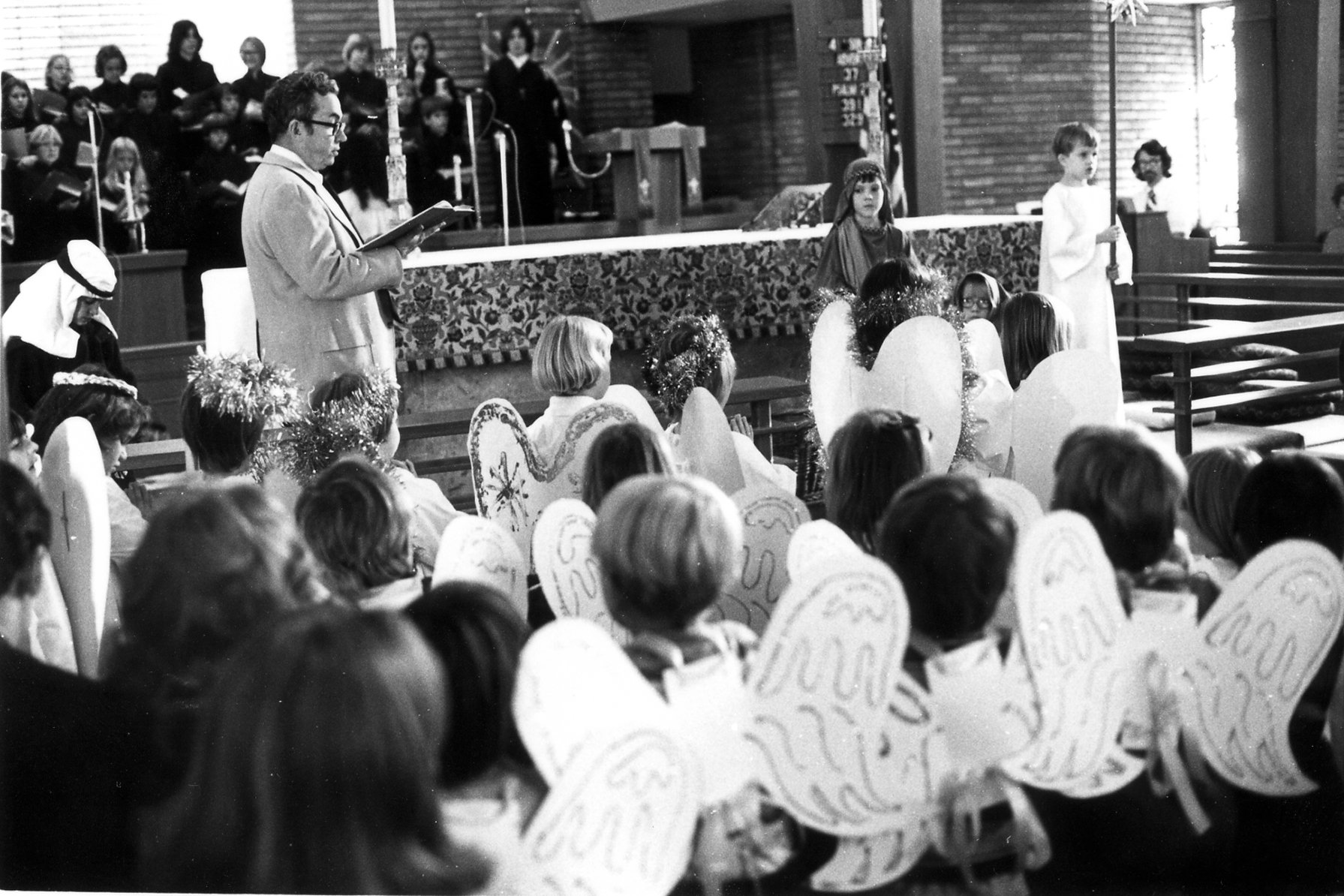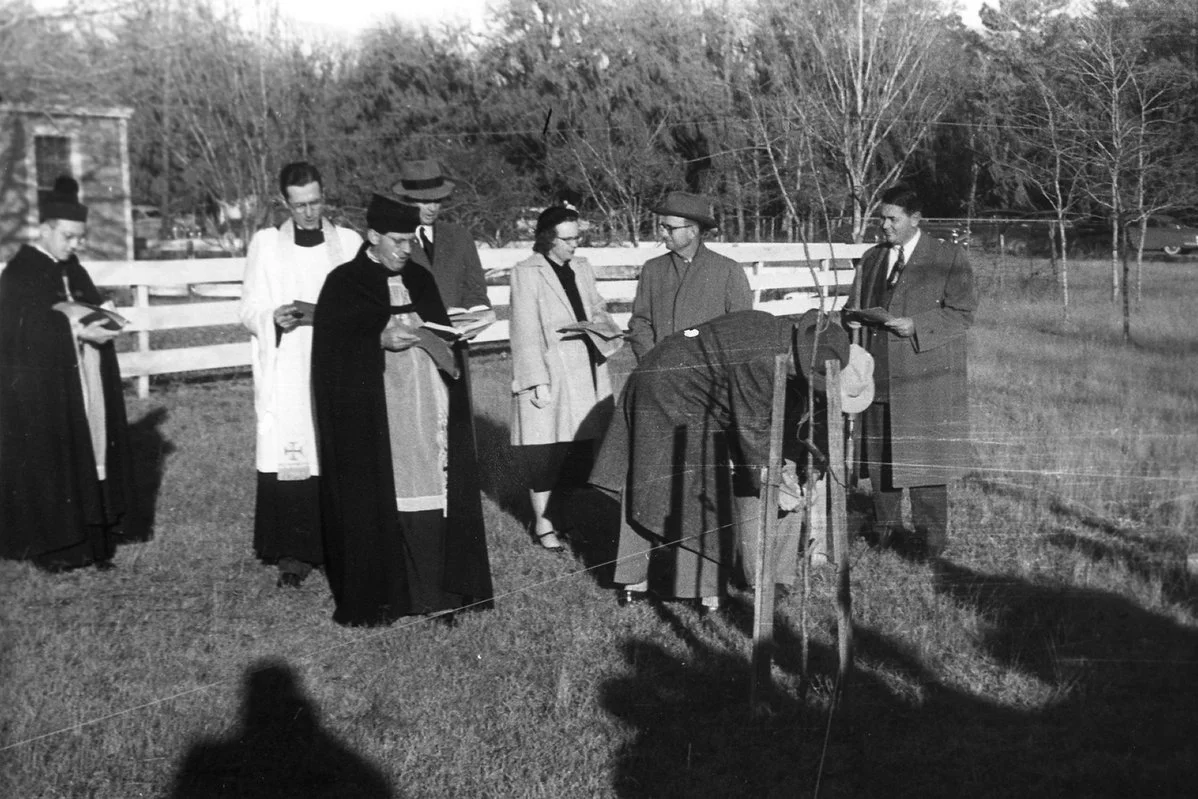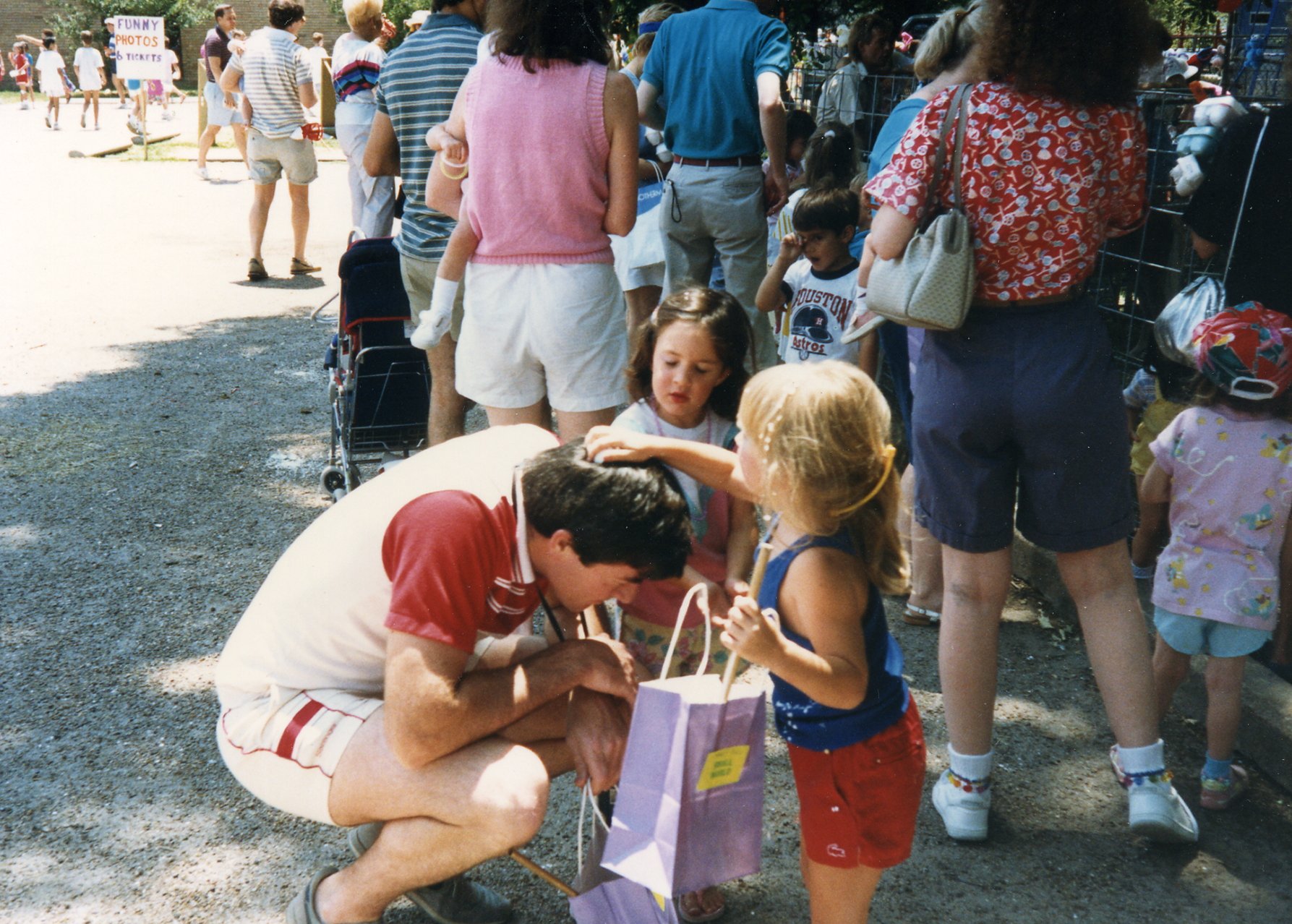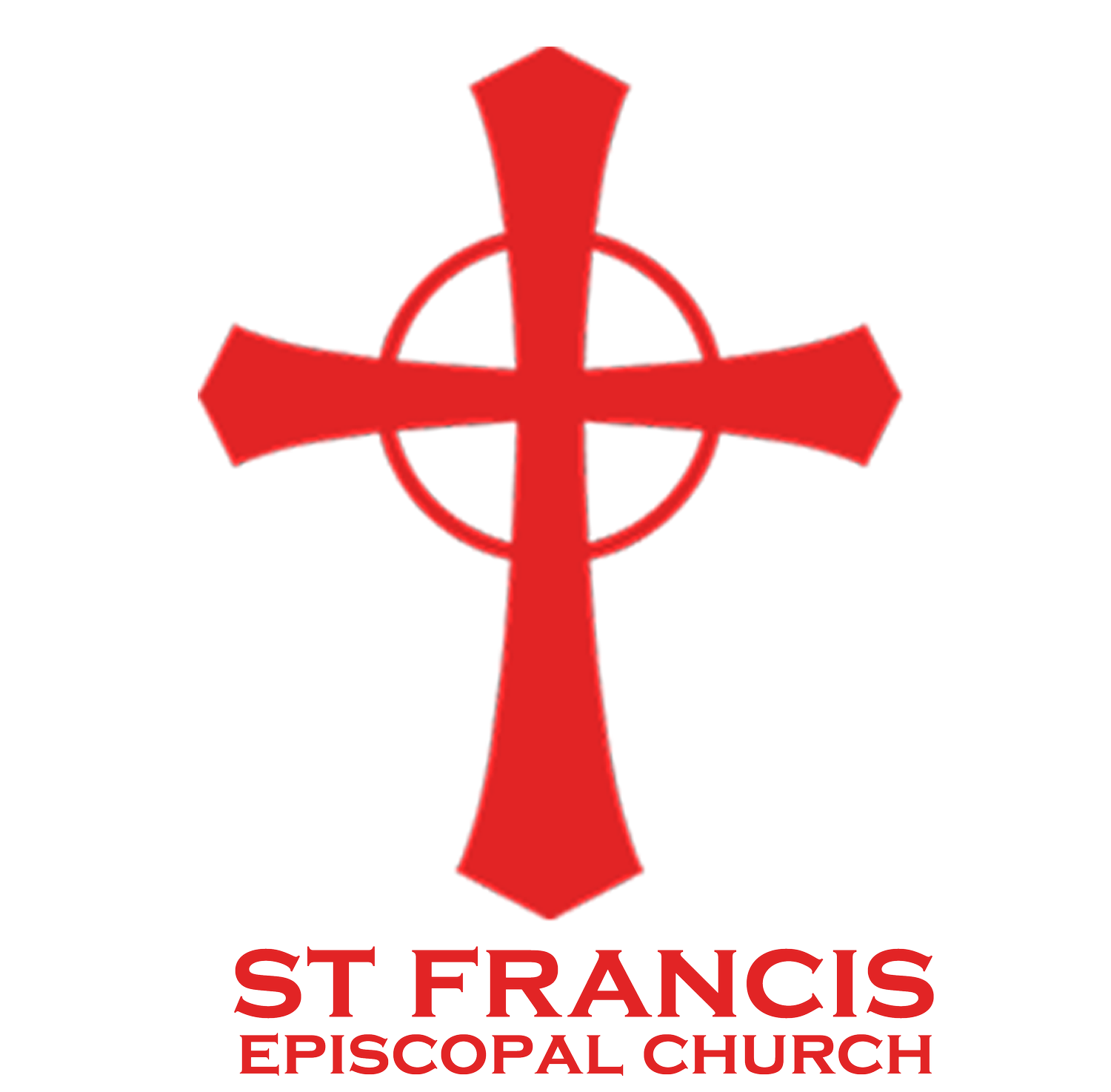
History
Our story began in 1949…
In 1949, a new church was needed to serve the far western edge of Houston. The first service of what would be St. Francis was then held in August. The application was soon made for St. Francis to become a Mission of the Diocese of Texas. Exactly 75 years ago, on January 28, 1950, St. Francis was accepted as a mission of the Episcopal Church at the Diocese of Texas Council meeting. St. Francis Mission then began the work of establishing itself as a Parish, which it achieved in 1952.
The most important concern of the new Mission/Parish was clearly the Christian Education of children, as is evidenced by the 1950 Building Committee notes, which reported that “the Sunday School building should be the first part of the structure to be built…and that the remainder of the Church would be built later.” Groundbreaking for the Parish Hall took place in January 1951, with the first service held in the as-yet un-air-conditioned building in May 1951.
First Service
On August 28, 1949, the first worship service for what would become St. Francis Episcopal Church was conducted by Bishop Clinton S. Quin. It was held on the property belonging to Dr. Palmer Archer, located on Strey Lane at Memorial Drive. In preparation for this service trees had been cut down to clear a space for the gathering. Some of these trees were then used to make an Altar and communion rail, which were used at the initial service. A cross borrowed from St. John Divine, our sponsoring Parish, was used.
1951
In March 1951, a committee was appointed to begin discussing the opening of a day school at St. Francis to be incorporated and self-supporting. In September 1952, a special Vestry meeting approved the creation, and a class of 24 young children was enrolled in what we would call pre-school. Higher grades were added gradually over the years until St. Francis Episcopal School now has more than 1000 students from Pre-primary through High School, with an outstanding reputation.
Music in the Early Days of St. Francis
A portable military-surplus field organ, owned by Mrs. Charles Stone, the choir director, played an important role in both the groundbreaking for the Parish Hall and the weekly services held there beginning in 1951. Mrs. Stone transported the organ to and from her home on Hedwig Road near Beinhorn until she moved away in 1953. Ruth Mary Ruston was hired as full-time organist and choir director that year and had the use of an electric organ donated by St. John the Divine. (Ruth Mary began a tradition of musical excellence which continues to this day.)
Church for the Country West of Houston
In 1949, the Memorial area of Houston was definitely country, with few homes that were not farms. The western edge of Houston proper was Post Oak Road (now Boulevard). Memorial Drive was paved only as far west as Strey Lane, and the US 90, the current Katy Freeway, was a meandering two-lane roadway. Many homes along Piney Point Road had stables, and children on horseback were a frequent sight. This was the area to be served by the new Episcopal Parish. Among the first suggested names were St. Martin’s in the Fields and St. Francis in the Woods.
Dick Wheatcroft Appointed Vicar
The Rt. Reverend John E. Hines, Bishop Coadjutor in charge of mission congregations in the Diocese of Texas in 1949, called G. Richard Wheatcroft, from Trinity Church in Kirksville, Missouri, to Houston to serve a new church being formed “out west.” He preached his first sermon in May 1950 and was instituted as Rector on March 23, 1952, the beginning of a 40-year tenure. As there was as yet no worship space on Piney Point Road, permission was obtained to hold services in the Spring Branch School auditorium, with Sunday School classes held in the school classrooms.
Capital Campaign / Construction of Original Parish Hall
In 1951, a Building Committee was appointed to explore construction of a building at 345 Piney Point Road. The proposed Parish Hall construction was unanimously approved by the congregation and the Building Fund Campaign Committee was successful in raising a substantial sum, both within and outside the Parish, requiring only a small loan from the Great Southern Life Insurance Co. Parishioners generously provided a substantial amount of the expertise needed at no charge or at cost, allowing the building and a small addition to the Rectory to be completed for $55,000.
Chapel of St. Clare
When our church building was rebuilt and enlarged in 2000, a chapel was included at the east end of the building. In December of 2002, about a year after the new building was dedicated, the congregation was invited to propose a name for the new chapel, including supporting material for the appropriateness of the suggestion. In March 2003, the name was announced as the Chapel of St. Clare. A contemporary of St. Francis and inspired by his example, Clare became the abbess of a community that followed his rule and spirit. Francis regarded Clare as a shining example of integrity and service and often consulted her during his ministry.
Needlepoint Altar Cushions
Most of us do not recognize the names of Alice and Allen Hannay, Jr., but they are the long-ago members responsible for our beautiful Altar Cushions. On the occasion of her husband’s death, Mrs. Hannay and other Altar Guild members planned and designed the original 12 cushions we still use today. The materials were paid for from the Memorial funds donated following Mr. Hannay’s 1972 death. After Mrs. Hannay’s death in 1973, the work was completed by the 34 women she had recruited for the project. It has been estimated that 9500 hours of patient stitching were needed to produce the beautiful cushions!
Stained Glass Windows
With one exception, the stained-glass windows in the current church building are all from the original Sanctuary. The large windows in the transepts are in their original positions. The Creation window on the north side contains images of the sun, the moon, plants, birds, and animals, as well as the Hand of God. The Hymn to the Sun on the south side has uplifted hands, the sun, a bird, flowing water, and a monkey. Small windows have been stacked to form the large windows in the Nave. Others are used in the high windows in the transepts and choir area. Faceted glass windows, once used along the aisles of the Nave and transepts of the original Sanctuary, are now effectively displayed in the chapel.
The Schorre Window
Charles Schorre was an acclaimed Texas artist and long-time, very active Parishioner of St. Francis. The glass fresco window, “Cruciform 81”, located over the east entrance to the nave, is a photographic enlargement of an original painting showing Christ on the cross, as viewed from above. Charles’ family selected the painting and a large group of Charles’ friends and family members donated this lovely work, in memory of a beloved member of our community It was fabricated in Phoenix, AZ, by laminating the photo of the artwork between two pieces of glass, and is the only new window that was created specifically for use in the new 2000 Sanctuary.
The Icons in the Narthex
Our two beautiful icons were both written, the term used for Icon creation, by Diamantis Cassis, and he has provided detailed descriptions of them, along with their numerous figures and symbols. These details can be found on cards in the small racks on the walls as you enter both doors. The Crucifixion Icon depicts Christ, erect and peaceful, almost as though resurrected. To his right is his mother, Mary, supported by the three other Marys. To his left is the beloved disciple John and the Centurion Longinus, reported to be a convert to Christianity after the crucifixion. The Resurrection Icon is one of two traditional depictions, called the Theological Resurrection, showing Christ descending into and breaking the gates of Hades, freeing humanity from death. Adam and Eve, symbolizing humanity, are shown being lifted up by Christ from their death.
In 1977, a group of mothers from St. Francis Church and Day School, with the encouragement of the church Rector and the school Principal, formed the You & Your Children Committee. The committee was created to provide lectures and seminars on child-rearing topics. Professional educators, child psychologists and other experts were invited to speak, providing guidance on a variety of topics, including building strong values, healthy relationships and handling stress. In addition, the committee took a leadership role in developing a strong summer reading program in consultation with educators and librarians. Ice cream parties were held to inspire children to read more. In 1999, Y&YC was discontinued, leaving behind a thriving summer reading program and the Art a la Carte Program.
You & Your Children Committee
Art a la Carte
In the spring of 1986, the Art a la Carte program was begun by the You & Your Children Committee to aid in efforts to enrich the fine arts curriculum of SFES. Volunteer parents from the church and school worked together to develop classroom programs for kindergarten and first graders, introducing the elements necessary for understanding art, such as form, color, line, and subject matter. Volunteer docents were trained by professional art and museum educators. The program grew to include all students from kindergarten through eighth grade. Through combined grants from the Meadows Foundation in Dallas and the Day School, a Rice University graduate with a degree in Art History was hired to complete the development of the program. The St. Francis Art a la Carte Program attracted the attention of other private schools, which purchased the curriculum for use in their schools.
Expanded roles of Lay Persons and all Baptized Believers
In 1967, the national church created a greater role for Lay Persons in the life of the Parish. That year, the Canons of the national Episcopal Church changed the word “Layman” to “Lay Person.” With that change, women could join men to serve on Vestries and as delegates to councils, and both boys and girls could be acolytes. Worship services began using Lay Persons, both men and women, as readers and chalice bearers. Other changes in 1970 permitted baptized children to take Holy Communion, previously not allowed until after Confirmation. In the newly revised 1979 Book of Common Prayer, the requirement of confirmation to take communion was removed, thereby welcoming all baptized believers to participate in the Eucharist. In some Parishes, these changes were slow to be implemented, but St. Francis welcomed the changes and immediately incorporated them into Parish life. Today, St. Francis thrives on the role of Lay Persons in worship and welcomes all baptized believers to participate in the sacramental life of the Parish.
Outreach at St. Francis
At St. Francis Church and School, we are a people for others, and that mantra has been instilled into the church and school community since inception. Outreach to those in need has always been an important emphasis at St. Francis. Volunteering at Spring Branch Hospital is one of the first outreach activities described in early history documents of the parish. Weekly food donations for Fair Haven Food Pantry have been a long-standing tradition. St. Francis is a founding parish of Memorial Area Ministries. Every fall, the church and school collect hundreds of coats for Kitty’s Coats, which are distributed to children in the Spring Branch School District. Every spring, the church collects clothing, shoes, and handbags for Dress for Success, an international non-profit providing clothes for women newly returning to work. The Christmas Angel Tree, a beloved Advent tradition, collects gifts for children from Positive Black Male Assoc. (PBMA), Brigid’s Hope, and Woodview Elementary. It typically brings in so many gifts that multiple large cars are required to deliver everything. St. Francis provides volunteers for the Reading Buddies program at Woodview Elementary, and each year’s confirmation classes spend time helping out at Lord of the Streets and the Beacon.
Continuing Music Excellence at St. Francis with Rick Keith
Fr. Bates brought a truly gifted musician to St. Francis when he persuaded Rick Keith to expand his role at the Day School and take on the role of music director at the church. Rick was a musical genius and the first person to receive a music degree in both Composition and Conducting from the University of California, Santa Barbara. Through his genius and tireless work, St. Francis’ music program flourished: in collaboration with the clergy, he worked to create the contemporary family service at 9 AM; he recruited singers and a “Praise Band” for contemporary music at that service; he recruited singers for the Assisi Choir at 11 AM, encouraging student musicians to sit in and play along at both services; he expanded the 11 AM service music by including the Fine Arts Strings and Dr. Danny Kelly, playing traditional piano; he established and led a handbell choir and produced a variety of outstanding evening music programs, to which the public was invited, and he brought together diverse musicians to provide music for St. Francis traditions, such as the Shrove Tuesday pancake supper and the Christmas Sing-along. These numerous activities took place while Rick provided music for the school’s weekly chapel services on both campuses. For 10 years, Rick worked with a group of musical theater professionals to hold SCENES, a summer camp for children aged 7-17, producing a full-blown musical theater piece in one- or two-week sessions. These enormously popular camp offerings only ended when construction denied access to the performance space needed. Rick’s untimely death in August 2024 was a loss felt deeply by the entire St. Francis community and across his wide family of students, collaborators and admirers.
Summer Musical Theater Camp
In 2009, the very first session of SCENES, a Musical Theater camp for children began at St. Francis church and school. Children from Kindergarten to high school worked with theater professionals to produce full Broadway-style productions with live music. Under the direction of veteran directors CeCe Prudhomme and Yvonne Guidry, choreographer Patricia Salvo and music director Rick Keith campers worked on skills in acting, vocals, dance and theater/stage production. Each camp session, one-week for the younger group and two weeks for the older, culminated in a weekend performance, the first of which was Godspell. Other productions included Peter Pan, the Jungle Book, Cats, Annie Seussical and the Lion King. As the camp became known, students from many schools participated, including Kinkaid, St. John’s, Memorial Middle School, Cornerstone Academy, Stratford HS and Trinity Classical School. The camps ended in 2019 when the construction on the new Parish Hall prevented access to the St. Francis grounds, but are remembered for their valuable contribution to arts education in our wider community and for the happy and fun experience they provided for so many!
Listen to a special podcast episode about the history of Saint Francis Episcopal church here. Click the image to play.

Gallery
















